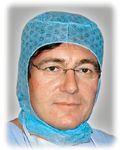Article
Sling shows efficacy in male stress incontinence
Atlanta-The transobturator approach for sling placement may result in decreased pad use and overall patient satisfaction in men with stress urinary incontinence, according to the preliminary findings of a small study presented by Peter Rehder, MD, a urologist at the University of Innsbruck, Austria. The data were reported at the AUA annual meeting here.

This procedure represents a relatively recent innovation in minimally invasive surgery for stress incontinence and is considered less invasive than the gold standard treatment, artificial urinary sphincter placement.

The study by Dr. Rehder, Georg Bartsch, MD, and Christian Gozzi, MD (who co-developed the new procedure with Dr. Rehder) included 18 men. Of those, 16 had undergone radical prostatectomy, one had undergone a radical cystectomy, and one had undergone transurethral needle ablation and three transurethral resections of the prostate. All patients underwent pre-and postoperative imaging.
A helical rounded-tip needle was introduced "outside-in" high into the obturator foramen and directed onto a finger placed between the corpus spongiosum and corpus cavernosum. Polypropylene tape was then fixed to the spongiosum and pulled through the obturator fossae without further fixation.
For the pilot study, the researchers used a prototype device that was not ideal due to the size of the needles and the design of the sling. However, it was sufficient to demonstrate the efficacy of the mechanism of action for the procedure.
Patients reported the number of pads they used before the procedure and at a postoperative time point ranging from 26 days to 17 months. They also completed a non-validated questionnaire that assessed their satisfaction with the procedure.
All 18 patients underwent successful implantation of the sling, and all reported a decrease in pad use after the procedure. At baseline, nearly three-fourths of the patients reported using more than five pads per day, whereas after the procedure, all patients used fewer than five pads per day (one-third used no pads, one-third used one to two pads, and one-third used three to four pads).
Sixteen patients were asked to complete the satisfaction questionnaire, and 13 completed it. Of those, seven reported being very satisfied with the procedure, two were satisfied, three were neutral, and one patient, who had no preoperative sphincter function, reported being dissatisfied.
No device-related adverse events were reported, with the exception of a return to baseline incontinence in one patient who lifted a heavy object 1 to 2 weeks after the procedure.
"We worked with American Medical Systems [Minnetonka, MN] to optimize the needles and sling mesh to accommodate the male pelvis and fit the posterior bulb," Dr. Rehder noted. "We have since implanted 18 of the optimized devices (AdVance Male Sling, AMS) and have seen outstanding results."
AMS has begun a multicenter trial in the United States and will begin one in Europe soon to evaluate this procedure.
Potential seen
Shlomo Raz, MD, professor of urology at ULCA, pointed out that passive compression was the operation most commonly used for male incontinence in the 1970s.
"Despite encouraging initial results, the procedure was abandoned for the more physiologically active compression achieved with the artificial urinary sphincter," Dr. Raz told Urology Times.




